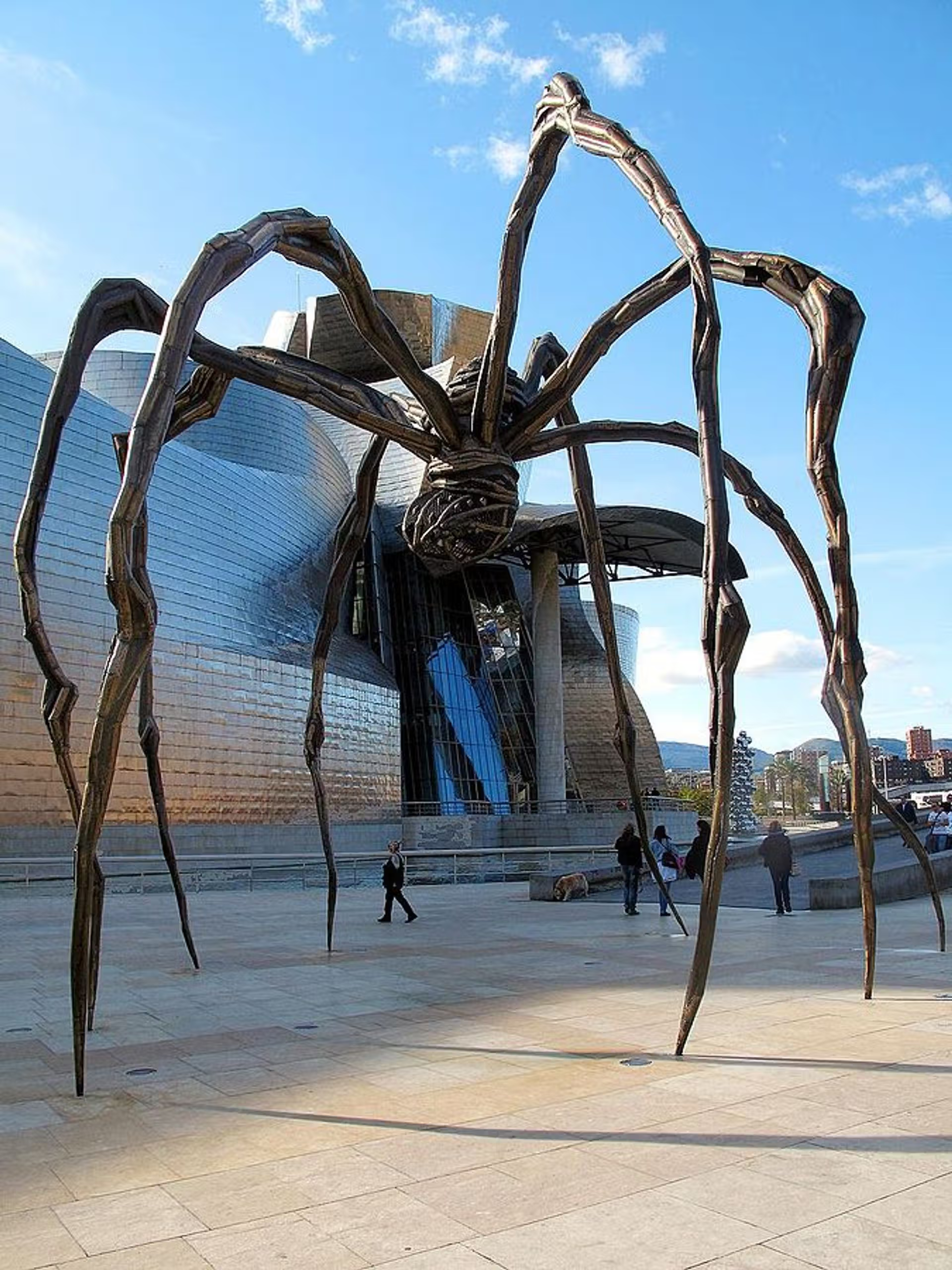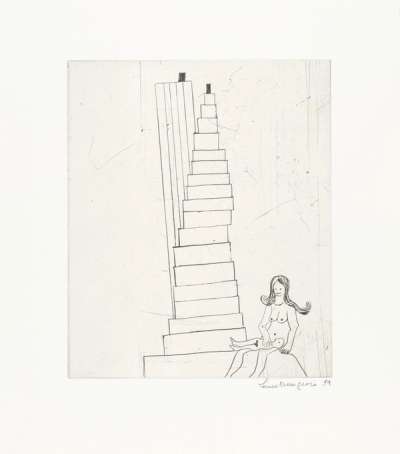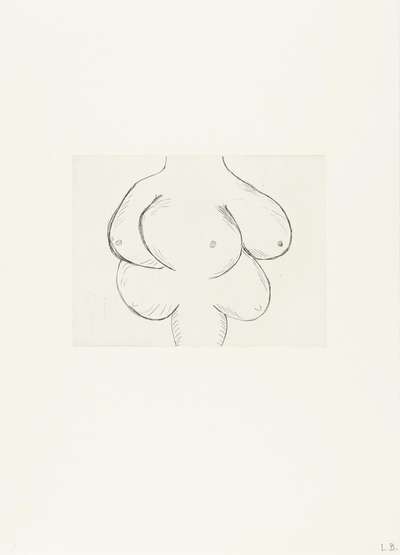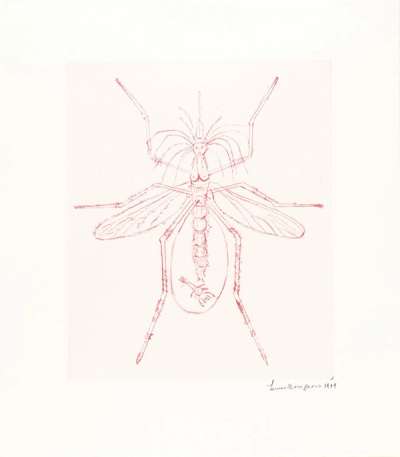 Mother And Child © Louise Bourgeois 1999
Mother And Child © Louise Bourgeois 1999
Interested in buying or selling
Louise Bourgeois?

Louise Bourgeois
104 works
Louise Bourgeois' art is an exploration of femininity and form, captivating viewers with its raw emotion and complex symbolism. Through her sculptures, installations, and drawings, Bourgeois navigated the depths of human experience, weaving her personal history with universal themes of birth, death, love, and fear. Her work, marked by the recurring motif of the body, challenges traditional representations of femininity, offering a narrative that is both intimate and universally resonant. By embodying the tensions between strength and vulnerability, presence and absence, Bourgeois' creations invite us to confront the intricacies of our own identities and the societal constructs that shape them.
Bourgeois’ Journey to Femininity & Form
Bourgeois was born in Paris in 1911, into a family entrenched in the restoration of antique tapestries. Her early exposure to the art of weaving and repair – a meticulous process of reconstructing narratives within fabric – foreshadowed the complex layers of memory and emotion that would later characterise her artwork. Bourgeois witnessed firsthand the interplay of strength and fragility, themes that would deeply influence her exploration of femininity and form.Her childhood was marked by her father's infidelity, a trauma that Bourgeois would later confront through her art. The betrayal, coupled with her mother's stoic resilience, instilled in Bourgeois a nuanced understanding of the complexities of human relationships, particularly the power dynamics within family structures. This understanding became a foundational element in her work, where the body often serves as a battleground for emotional conflicts.
Bourgeois moved to New York in 1938 after studying at the Sorbonne and marrying American art historian Robert Goldwater. This relocation marked a pivotal shift in her journey, immersing her in the burgeoning post-war art scene. However, it was her personal struggles, including her experience as a mother and her battles with anxiety and depression, that shaped her thematic approach. Bourgeois frequently engaged in psychoanalysis, and this introspection is evident in her work, which explores the depths of psychoanalytical theory with both courage and vulnerability.
The Body in Bourgeois' Art: A Canvas for Exploring Femininity
Maman
One of Bourgeois' most iconic sculptures, Maman, serves as a monumental homage to motherhood and maternal instinct. The towering spider structure, crafted in bronze, stainless steel, and marble, stands as a protective figure, embodying strength, nurturing, and the complexity of maternal bonds. Maman explores the duality of the mother figure – a creator and protector, yet also an entangler in her web. Bourgeois' own relationship with her mother, whom she revered as a weaver of the family's fabric and a repairer of broken narratives, deeply informs this piece. The sculpture invites viewers to confront their own perceptions of motherhood and femininity, oscillating between comfort and unease, reflecting the layered emotions tied to the maternal figure.
Arch of Hysteria
In Arch of Hysteria, Bourgeois presents a gender-ambiguous, headless bronze torso suspended in an arch, capturing a moment of intense emotional and physical release. This work examines the historical and psychoanalytic connotations of hysteria, a diagnosis historically ascribed predominantly to women and laden with misconceptions of female vulnerability and irrationality. By stripping the figure of gendered markers and a head, Bourgeois universalises the experience of hysteria, challenging the stigmatisation of emotional expression and reclaiming it as a source of power. The sculpture embodies the liberation found in the abandonment to feeling, suggesting that vulnerability and strength are not mutually exclusive but interconnected facets of human experience.
 Image © Museum of Modern Art / Femme Maison © Louise Bourgeois 1994
Image © Museum of Modern Art / Femme Maison © Louise Bourgeois 1994Femme Maison
The series of drawings and paintings titled Femme Maison (Housewife or literally Woman House) further exemplifies Bourgeois' exploration of femininity and identity. These works depict women with houses for bodies, obscuring their heads and merging their identities with domestic spaces. This imagery critiques the reduction of women's roles to their domestic duties, highlighting the conflict between personal identity and societal expectations. Bourgeois' Femme Maison series invites reflection on the ways in which women navigate and resist the constraints imposed on them, seeking to reconcile their inner selves with external perceptions. The house, simultaneously a symbol of security and confinement, becomes a metaphor for the complexities of female identity within societal structures.
Techniques and Materials: Conveying Complexity
Bronze
Bourgeois frequently employed bronze in her sculptures, valuing its durability and the way its surface interacts with light. Works like Maman and Arch of Hysteria showcase bronze's capacity to capture both the delicacy of a spider's web and the intense dynamism of a contorted body. The reflective quality of bronze mirrors the complexity of the emotions Bourgeois aims to evoke, allowing the sculptures to change with the surrounding light and the viewer’s perspective, thus embodying the fluidity of human emotion and the multifaceted nature of femininity.
Fabric
Fabric plays a central role in Bourgeois' exploration of memory, domesticity, and femininity. Utilising garments, linens, and textiles from her personal collection, she created soft sculptures and installations that evoke the warmth and intimacy of familial relationships, as well as the constraints of domestic roles. The use of fabric, a material imbued with domestic connotations, in works such as the Cells series and Femme Maison, bridges the gap between public art and personal space, inviting viewers into a more intimate dialogue with the work. The tactile nature of these materials engages the sense of touch, suggesting a closeness that metal or stone cannot replicate, thus deepening the emotional engagement with the viewer.
Latex
In her exploration of organic forms and the body, Bourgeois turned to latex for its skin-like qualities and flexibility. The ephemeral nature of latex, which degrades over time, speaks to themes of impermanence, vulnerability, and the ageing process. This choice of material reflects Bourgeois' interest in the corporeal and transient aspects of human existence, emphasising the body’s fragility and the passage of time. Her latex pieces, often resembling flayed skin or internal organs, confront viewers with the rawness of bodily existence and the inherent vulnerability of femininity.
Marble
Bourgeois used marble to sculpt forms that evoke both the strength and the softness associated with femininity. Works carved in marble, such as the sleeping figures and the series of clasped hands, demonstrate her ability to render this hard stone into shapes that seem almost tender to the touch. Marble, with its historical associations with classical sculpture and permanence, allows Bourgeois to engage with the canon of art history while subverting traditional representations of the female form. Through marble, she communicates the resilience and enduring power of femininity, juxtaposing its solidity against the fluidity of the themes she explores.
Challenging and Redefining Femininity Beyond the Norm
Bourgeois’ oeuvre stands as a defiant counter-narrative to traditional representations of femininity and the female body in art. Her work not only interrogates the normative constructs of gender roles but also boldly redefines them, engaging in a dialogue that intersects with feminist and psychoanalytic discourses. Through her exploration of the body, Bourgeois challenges the passive, idealised images of women prevalent in art history, presenting instead a vision of femininity that is complex, multifaceted, and deeply human.
Challenging Traditional Representations
Historically, the portrayal of women in art has often been confined to passive roles, objectified and idealised through the male gaze. Bourgeois subverts these conventions by presenting the body in ways that defy idealisation, highlighting its imperfections, vulnerabilities, and strength. Her sculptures, often grotesque and unsettling, refuse to conform to traditional aesthetic norms, instead embracing the raw and the real. This approach not only challenges the viewer's expectations but also initiates a critical conversation about the ways in which femininity has been historically constructed and represented.
Intersection with Psychoanalytic Theory
Bourgeois' art is deeply imbued with psychoanalytic theory, reflecting her own engagement with psychoanalysis throughout her life. Her use of recurring motifs, such as the spider and the body, can be seen as symbols that represent both personal and universal anxieties, desires, and relationships. The psychoanalytic concept of the unconscious plays a significant role in her exploration of femininity, allowing Bourgeois to explore the depths of emotional and psychological experiences. This introspective approach opens up new avenues for understanding femininity, not as a static category, but as a fluid and evolving construct shaped by both personal trauma and societal pressures.
Redefining Femininity
Through her bold and unapologetic portrayal of the female experience, Bourgeois redefines femininity as a source of strength, complexity, and contradiction. Her work challenges the binary oppositions of male/female, strength/vulnerability, and public/private, suggesting instead a more fluid and inclusive understanding of gender.
The Ripple Effect of Bourgeois' Exploration
Impact on Subsequent Generations
Bourgeois' exploration of deeply personal themes through a wide range of materials and forms has paved the way for artists to delve into their own experiences with unprecedented honesty and depth. She demonstrated that art could serve as a means of psychological exploration and healing, encouraging a generation of artists to probe the complexities of their identities and societal roles. Women artists, in particular, have found in Bourgeois a role model for the expression of the female experience, transcending traditional boundaries and expectations. Her work challenges the viewer to reconsider preconceived notions of femininity, identity, and strength, thereby expanding the narrative space available to artists working within and against the grain of these themes.
Louise Bourgeois and Tracey Emin
Tracey Emin, a figure synonymous with autobiographical and confessional artwork, shares Bourgeois' commitment to exploring the self within her practice. Emin's work, which spans a variety of media including drawing, sculpture, and installation, echoes Bourgeois' in its raw, emotive exploration of sexuality, trauma, and womanhood. The thematic parallels between Emin's and Bourgeois' work, particularly their unapologetic focus on the female body and its experiences, highlight Bourgeois' significant influence on Emin and her contemporaries.
Emin's engagement with Bourgeois' legacy is perhaps most evident in their collaboration, Do Not Abandon Me, a series of works that fuse Emin's provocative drawings with Bourgeois' sculptural forms. This collaboration not only underscores the direct influence of Bourgeois on Emin's practice but also symbolises the passing of the torch from one generation to the next, illustrating the profound connections that bind artists across time and space.
Contributions to Broader Discussions
Bourgeois' oeuvre contributes significantly to broader discussions about the role of art in exploring and expressing the intricacies of the human condition. Through her work, Bourgeois posits art as a powerful tool for introspection, dialogue, and understanding, capable of bridging personal and collective narratives. Her influence extends beyond the visual arts, inspiring interdisciplinary conversations among psychologists, feminists, and cultural theorists. By intertwining the personal with the political, Bourgeois' art invites a reevaluation of the ways in which we understand identity, trauma, and resilience, making her a central figure in discussions about the capacity of art to reflect and shape human experience.




















